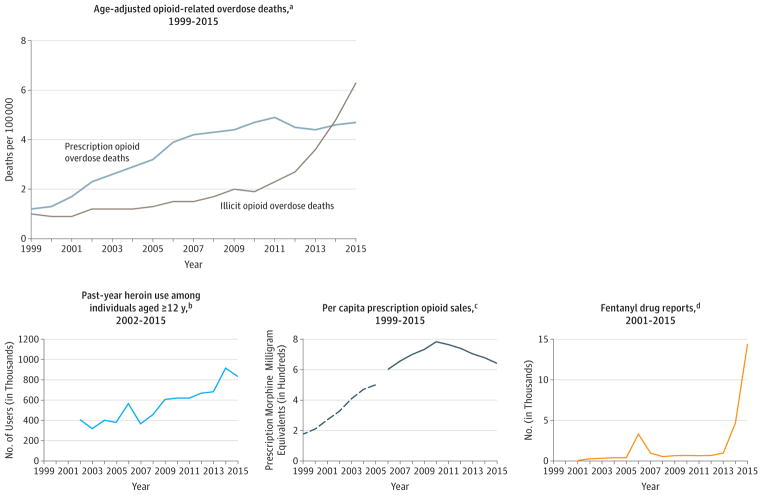Figure. Opioid Use and Overdose and Fentanyl Drug Reports, 1999–2015.
aSource: National Center for Health Statistics at the US Centers for Disease Control and Prevention. WONDER online database: prescription opioid overdose deaths include fatal overdoses related to natural and semisynthetic opioids or methadone. Illicit opioid-related overdose deaths are related to heroin or synthetic nonmethadone opioids, and some overdose deaths are related to prescribed fentanyl or other prescribed synthetic opioids.
bSource: Substance Abuse and Mental Health Services Administration. National Survey on Drug Use and Health. https://www.samhsa.gov/data/population-data-nsduh/reports?tab=38.
c Sources: Dashed line from 1999 to 2005 (Drug Enforcement Administration. Automation of Reports and Consolidated Orders System: sales to pharmacies, hospitals, and practitioners for codeine, fentanyl, hydrocodone, hydromorphone, meperidine, methadone, morphine, and oxycodone. Paulozzi LJ, et al. MMWR Morb Mortal Wkly Rep. 2011;60:1487–1492). Solid line from 2006 to 2015 (QuintilesIMS estimates of opioid prescriptions dispensed in the United States to 59 000 pharmacies, representing 88% of US prescriptions. Guy GP Jr, et al. MMWR Morb Mortal Wkly Rep. 2017;66:697–704).
dSource: Drug Enforcement Administration. Fentanyl, 2001–2015. https://www.deadiversion.usdoj.gov/nflis/2017fentanyl.pdf. The number of fentanyl drug reports reflects the number of encounters by law enforcement that tested positive for fentanyl. Therefore, fentanyl drug reports provide an indication of the available supply of illicitly manufactured fentanyl.

